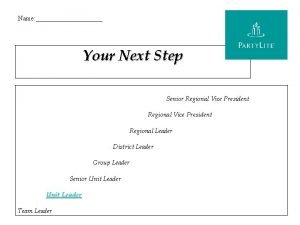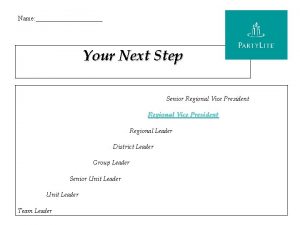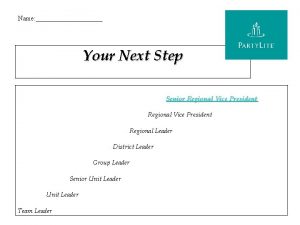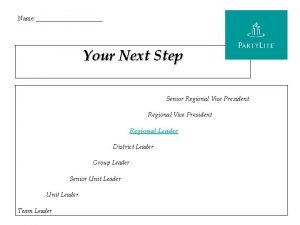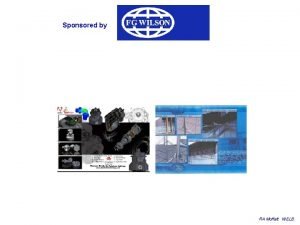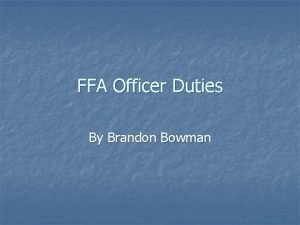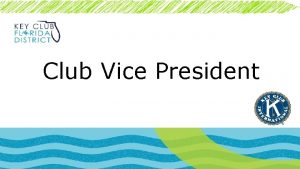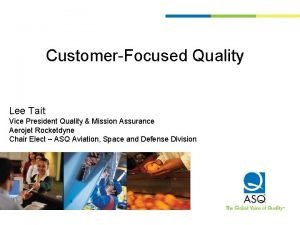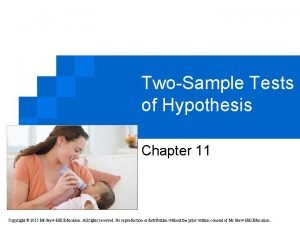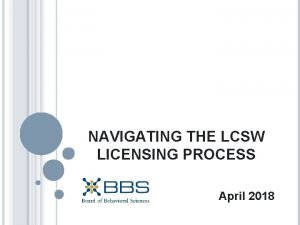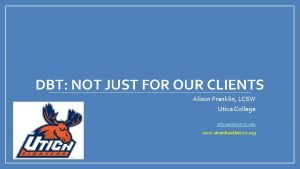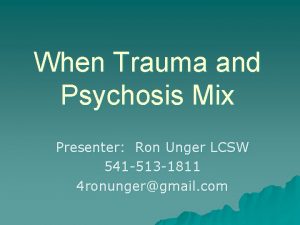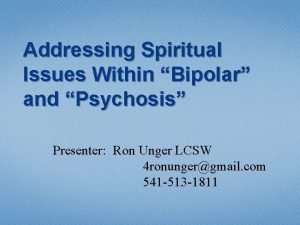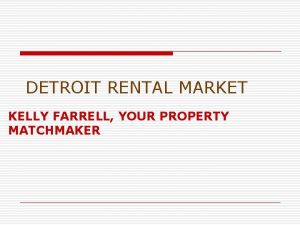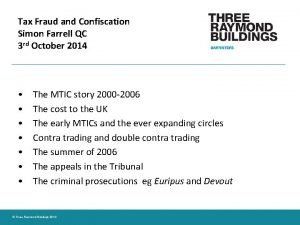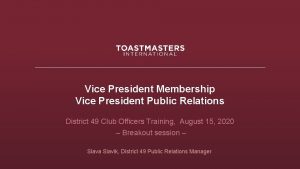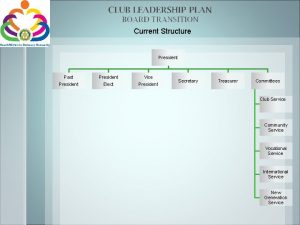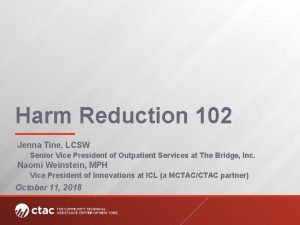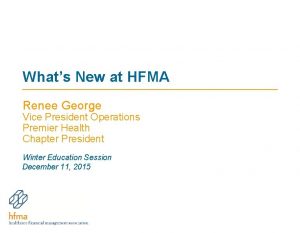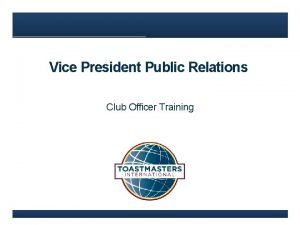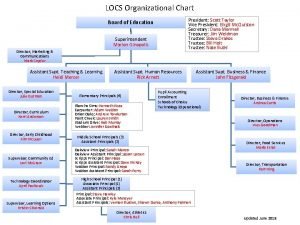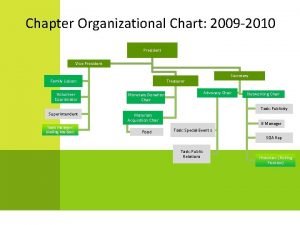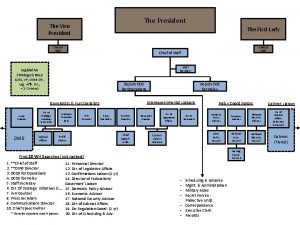Daniel Farrell LCSW Senior Vice President Renee Fueller




























- Slides: 28

Daniel Farrell, LCSW Senior Vice President Renee Fueller Executive Director, Homebase Network Tina Goodrich, MA Program Director, New Beginnings HELP USA

“Homelessness is such a disruption to one’s life; it’s hard to understate the damaging effects on a person or family system. ” Enduring Destructive Nature of Homelessness

Social Costs • Frequent use of emergency shelter, medical and mental health services, and public corrections (Padgett, Stanhope, Henwood, & Stefancic, 2009; Stein, Dixon, & Nyamathi, 2008; Culhane, 2002) • Gladwell’s, “Million Dollar Murray” (2006) which highlight chronic homelessness and the frequent utilization of emergency systems • Social disadvantage (Draine, Salzer, Culhane & Hadley, 2002) • Stigmatization (Phelan, Link, Moore & Stueve, 1997) Enduring Destructive Nature of Homelessness

Individual Costs • Incidence of sexual abuse and violence is much higher for homeless youth than for non-homeless youth (Swick, 2008; Rew, Fouladi, & Yockey, 2002) • Homeless adolescents are at higher risk for substance abuse, delinquency, victimization, physical and mental health problems (Zerger, Strehlow, & Gundlapalli, 2008; Milburn, et al, 2006) • Single homeless adults experience greater incidence of substance abuse and mental health issues (Mibly, et. al, 2010; Caton, Wilkens, & Anderson, 2007) Enduring Destructive Nature of Homelessness

Legal Costs • Homelessness strips basic liberties and equalities, as people experiencing homelessness lack basic acknowledgment by society (Wright, 2007 -2008) • People who are homeless lose their right to property, personhood, and protection against illegal search and seizure, as legal protections are contingent on having a private, personal space (Stec, 2006). • Homelessness is equated to being subjugated by the law in virtually all capacities, especially with many local anti-solicitation ordinances (Iwamoto, 2007 -2008) Enduring Destructive Nature of Homelessness

Subjective Experiences in Shelter • People living in a homeless shelter were highly critical of the services available to them (Hoffman & Coffey, 2008). Consistent responses included feeling “objectified” and “infantilized” • Shelter workers often do not view people experiencing homelessness from a client-centered perspective (Hartnett & Postmus, 2010) • Homeless shelters are generally constructed to ensure that basic physical needs are met, but are not concerned with providing a nurturing environment (Siegal, 2001) Enduring Destructive Nature of Homelessness

• Determinants of Homelessness are complex, multifaceted and everchanging • Cascading effects of multiple risk factors without sufficient protective factors as counterweight. Results in tipping point into homelessness • Convergence of multiple unfortunate micro (domestic violence, substance abuse) and macro factors (hot housing market) and destabilizing events (loss of income) (Lee, Tyler & Wright, 2010; Early, 2005; O’Flaherty, 2004) Determining Risk factors of Homelessness

HELP USA’s Homebase Homeless Prevention, Diversion and Aftercare Model Renee Fueller Support from NYC’s Human Resources Administration

• Homeless Prevention model • Prevent episode of homelessness by working with families and single adults identified as high risk for homelessness, and who are likely to enter into NYC’s shelter system (Primary) • Rapid Rehousing/Diversion model • Rapidly rehouse/divert families from shelter who experience literal homelessness • Aftercare model • Enroll families who are housed by shelter providers in zip codes served by Homebase Conceptual Framework of Homebase Homeless Prevention

• Targeting is vital to a successful homeless prevention or rapid re-housing program • Risk Assessment point system to assess and weigh correlates of homelessness (minimum of seven points determines risk) • Two points for each factor: • • Head of Household (HOH) is under 22 yrs. old Four or more moves in past year Severe household discord (subjectively determined) Two or more of individual factors as child: • • • Experience of Homelessness Foster care Physically, sexually or emotionally abused Moved four or more times Family received Public Assistance Targeting/Assessing Risk or Threat to Housing Stability

• One point for each factor: • • • HOH is between 23 and 28 yrs. old Receiving Public Assistance Involvement of children’s services or foster care Shelter stay in past three months Shelter stay as an adult One to three moves in past year Moderate household discord (subjectively determined) Non-leaseholder Return from institution: • Jail or Prison • In-patient substance abuse treatment or mental health facility Targeting/Assessing Risk or Threat to Housing Stability

• • Risk Assessment score of seven or more points Income under 30% area median income (AMI) 200% Federal Poverty Level (FPL) Geographic specificity to capture areas where high entrants into shelter system come from • Clustered areas of severe impoverishment Eligibility Criteria for Services

• Short-Term Financial Assistance • Rent arrears, security deposits, furniture, moving expenses • Ongoing rent contributions • Work expenses/training • Incentives (Payments to primary leaseholder) • Leverage financial assistance with other existing funding sources • Money management and household budgeting seminars • Housing Court assistance • Rehousing and/or diversion when appropriate Homebase Services

HELP USA’s Homebase Outcomes Daniel Farrell

• • FY 16 3397 unduplicated families (with children) were enrolled 968 unduplicated single adults were enrolled 4365 total unduplicated households were served 66 households entered shelter (98. 5% success…or 1. 5% failure rate) • Messeri, O’Flaherty & Goodman’s (2011) research on the effectiveness of Homebase finds that for every one hundred families enrolled, shelter entry falls between 10% to 20% • Rolston, et. al (2013) established a 6. 5% reduction of shelter entry of families enrolled in Homebase (and a reduction of length of stay for those who entered shelter) Outcome Data

3, 397 Unduplicated Families Entered Shelter 1. 5% HOMEBASE INTERVENTION 98. 5% Did Not Enter Shelter FY 16 Outcome Data 968 Unduplicated Single Adults

• Shelter costs approximately $38, 000 a year per family ($105 per night). In FY 16, the average length of stay is 13 months in a NYC family shelter ($41, 166) • Shelter costs approximately $27, 375 ($75 per night) a year for a single adult. The average length of stay is 10 months in a NYC shelter for single adults ($22, 810) • In FY 16, HELP USA’s Homebase programs cost eight million dollars • Homebase cost per family unit is $1832 per year The Cost Effectiveness of Homeless Prevention

• Messeri, O’Flaherty & Goodman’s (2011) research on the effectiveness of Homebase homeless prevention finds that for every one hundred families enrolled, shelter entry falls between 10% to 20% • Rolston, et. al (2013) established a 6. 5% reduction of shelter entry of families enrolled in Homebase (and a reduction of length of stay for those who entered shelter) Investing in Homeless Prevention; Cost Analysis

In FY 16, 4365 Unduplicated Family Units Received HOMEBASE Services Not every family unit would have become homeless without intervention But some would have: If 20% became homeless If 15% became homeless If 10% became homeless If 6. 5% became homeless 873 655 436 284 total families would have experienced homelessness 807 589 370 218 more than with Homebase Savings of $21 M $13. 2 M Savings of Costs $175, 000 more with Homebase $5. 3 M

• Homelessness prevention is less expensive and has shown to be effective in American localities and countries including Germany and England (Culhane, Metraux, & Byrne, 2011) • Homeless prevention must be expanded from its current and limited program design, which most often enrolls people who are at the most imminent, emergent risk of homelessness, in order to catch people “further upstream” (Shinn, Baumohl, & Hopper, 2001) Efficacy of Homebase Model

• Homelessness as economic rational choice? Impoverished people have a scarcity of resources, making “choices” based on opportunity costs (Quigley, Raphael & Smolensky, 2001; Wright, 1996; Friedman and Hetcher, 1988) • Is there a, “Sophie’s choice” as it relates to housing and homelessness at critical times? • What if homeless prevention can intervene right at, or just before that choice had to be made? • Or should interventions be targeted well before the housing crisis might reach a “cresting or tipping point”? Determining Risk Factors of Homelessness – Choices?

HELP USA’s New Beginnings Critical Time Intervention Program Tina Goodrich Support from the Robin Hood Foundation

• Behavioral economics offers a unique perspective into the phenomenon of homelessness • By understanding how and why individuals are forced to make choices that may result in a housing crisis and/or literal homelessness, this method offers insight into how upstream interventions, through curating of critically timed choice sets can preserve housing in the long term • Target population is young adults ages 18 -24 (with children) whose case is being resolved by Homebase Conceptual Framework

• Normative life events are stressful • Marriage • Residential relocation • Change of job • Non-Normative events are unduly stressful, which can lead to poor decision making processes • • • Young head of household Minimal or faulty social supports Poverty Unemployment or low wages Domestic violence & abuse Experiences of homelessness, institutionalization, etc.

Intervention is grounded in Critical Time Intervention “CTI” Framework • • Housing Stability Education Employment Health Care Mental Health Needs Child Care Utilization Quasi-Experimental Study that will test outcome against similar cohort who will not receive intervention (based on funding limitation) Conceptual Framework

Year One Baseline Data on Different Indicators

Type of Assistance Description # of HOH’s Provided Assistance Total Active Clients Prevention, Diversion, After Care, LINC or NYCHA 108 Prevention/Utilities Clients at imminent risk of becoming homeless 79 Diversion Clients who entered NYC shelter system and were diverted back to family/friend while Home. Base and New Beginnings work toward resolution of the housing crisis. 03 Aftercare, LINC or NYCHA Clients who exited the shelter system with a housing subsidy Home. Base will provide services to assist with any housing crisis to prevent losing apartment. 26 Services Provided

• • Enrollment of 200 Head of Household Independent Evaluator to Assess for Efficacy Screening for Depression Clients who are pregnant and/or gave birth during enrollment What’s New for Year Two
 Ducks unlimited checks
Ducks unlimited checks Senior regional vice president
Senior regional vice president Senior regional vice president
Senior regional vice president Senior regional vice president
Senior regional vice president Senior regional vice president
Senior regional vice president Vice president membership
Vice president membership Vice president training
Vice president training Microsoft executive briefing center
Microsoft executive briefing center Blue and gold basics ffa officers and meetings
Blue and gold basics ffa officers and meetings Age of vice president
Age of vice president Ffa officers duties
Ffa officers duties Vice president of club duties
Vice president of club duties Vice president training
Vice president training Lee tait
Lee tait Mary jo fitzpatrick is the vice president
Mary jo fitzpatrick is the vice president Bbs asw
Bbs asw Alison franklin
Alison franklin Ron unger lcsw
Ron unger lcsw Ron unger lcsw
Ron unger lcsw Dr julie larson
Dr julie larson Julie larson lcsw
Julie larson lcsw Stacy o'farrell santa cruz
Stacy o'farrell santa cruz Detroit rental market
Detroit rental market Christ be our light shine in our hearts
Christ be our light shine in our hearts Who is farrell jarreau
Who is farrell jarreau Byron farrell
Byron farrell Simon farrell qc
Simon farrell qc Enteralite infinity no flow out
Enteralite infinity no flow out Renee olstead forum
Renee olstead forum

